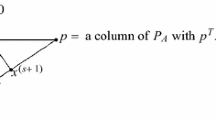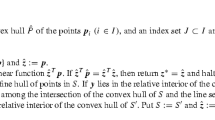Abstract
The Linear Programming Problem is manipulated to be stated as a Non-Linear Programming Problem in which Karmarkar's logarithmic potential function is minimized in the positive cone generated by the original feasible set. The resulting problem is then solved by a master algorithm that iteratively rescales the problem and calls an internal unconstrained non-linear programming algorithm. Several different procedures for the internal algorithm are proposed, giving priority either to the reduction of the potential function or of the actual cost. We show that Karmarkar's algorithm is equivalent to this method in the special case in which the internal algorithm is reduced to a single steepest descent iteration. All variants of the new algorithm have the same complexity as Karmarkar's method, but the amount of computation is reduced by the fact that only one projection matrix must be calculated for each call of the internal algorithm.
Similar content being viewed by others
References
I. Adler, M. Resende and G. Veiga, “An implementation of Karmarkar's algorithm for linear programming,” Report ORC86-8, Operations Research Center, University of California (Berkeley, CA, 1986).
K. Anstreicher, “A monotonic projective algorithm for fractional linear programming,”Algorithmica 1 (1986) 483–498.
T. Cavalier and A. Soyster, “Some computational experience and a modification of the Karmarkar algorithm,” Working Paper 85-105, Dept. of Industrial and Management System Eng., Pennsylvania State University (University Park, PA, 1985).
D. Gay, “A variant of Karmarkar's linear programming algorithm for problems in standard form,”Mathematical Programming 37 (1987) 81–90.
P. Gill, W. Murray, M. Saunders, J. Tomlin and M. Wright, “On projected Newton barrier methods for linear programming and an equivalence to Karmarkar's projective method,”Mathematical Programming 36 (1986) 183–209.
C. Gonzaga, “A conical projection algorithm for linear programming,” memorandum No. UCB/ERL M85/61, Electronics Research Laboratory, University of California (Berkeley, CA, 1985).
M. Heath, “Some extensions of an algorithm for sparse linear least squares problems,”SIAM Journal on Scientific and Statistical Computing 3 (1982) 223–237.
M. Iri and H. Imai, “A multiplicative barrier function method for linear programming,”Algorithmica 1 (1986) 455–482.
N. Karmarkar, “A new polynomial time algorithm for linear programming,”Combinatorica 4 (1984) 373–395.
W. Murray and M. Wright, “Efficient linear search algorithms for the logarithmic barrier function,” Report SOL 76-18, Dept. of Operations Research (Stanford, CA, 1976).
M. Padberg, “Solution of a nonlinear programming problem arising in the projective method for linear programming,” Manuscript, New York University (New York, NY, 1985).
R.T. Rockafellar,Convex Analysis (Princeton University Press, Princeton, NJ, 1970).
M. Todd and B. Burrell, “An extension of Karmarkar's algorithm for linear programming using dual variables,”Algorithmica 1 (1986) 409–424.
Y. Ye, “A large group of projections for linear programming,” Manuscript, Engineering-Economic System Dept., Stanford University (Stanford, CA, 1985).
Author information
Authors and Affiliations
Additional information
Research partly sponsored by CNPq-Brazilian National Council for Scientific and Technological Development, by National Science Foundation grant ECS-857362, Office of Naval Research contract N00014-86-K-0295, and AFOSR grant 86-0116.
On leave from COPPE-Federal University of Rio de Janeiro, Cx. Postal 68511, 21941 Rio de Janeiro, RJ, Brasil.
Rights and permissions
About this article
Cite this article
Gonzaga, C.C. Conical projection algorithms for linear programming. Mathematical Programming 43, 151–173 (1989). https://doi.org/10.1007/BF01582287
Received:
Revised:
Issue Date:
DOI: https://doi.org/10.1007/BF01582287




